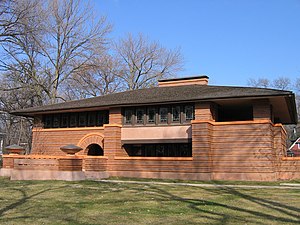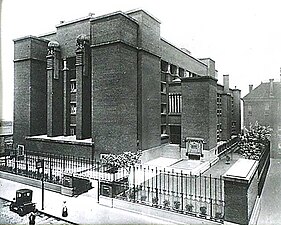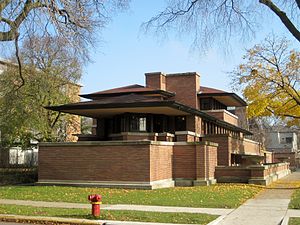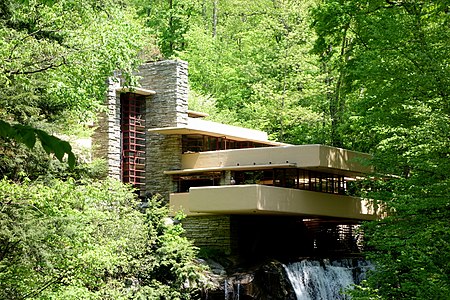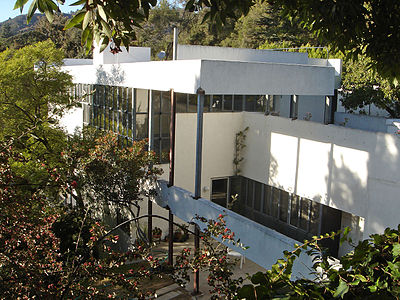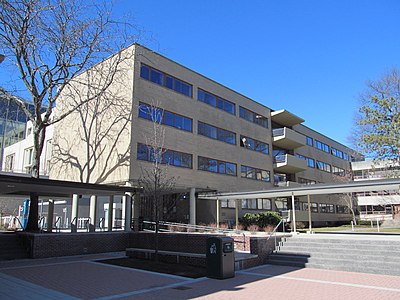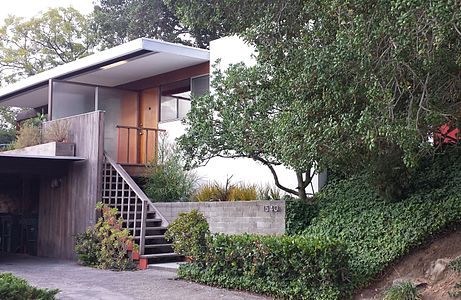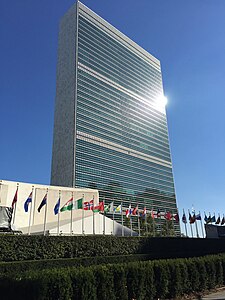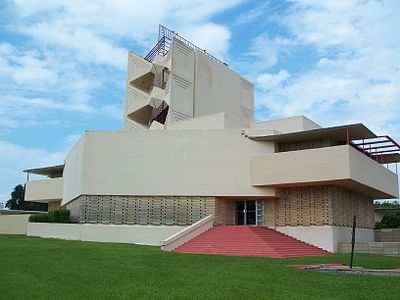American modern architecture - Simple English Wikipedia, the free encyclopedia

American modern architecture was a movement or style that occurred in the United States approximately between the 1890s and the 1980s.[1]
Terminology[change | change source]
Disambiguation and diversity of terms[change | change source]
The term refers to the buildings and architects of modernism or modern architecture in English,[1][2] which had nothing to do with the meaning of the term (linked to Art Nouveau) in the Iberian Peninsula, before the World War II, what is called in English modernisme.[3][4]
In some romance languages, such as Brazilian Portuguese, the term modernismo or arquitetura moderna is similar to its meaning in English.[5]
The modern movement or international style does not have a homogeneous name in all countries and languages. In many, the term "International Style" is used.[6]
A synonymous term is “Modern Movement”, from the book Pioneers of Modern Movement from William Morris to Walter Gropius (1936), by Nikolaus Pevsner.[7]
Origin[change | change source]
The word "modernism" comes from a book by Hitchcock and Johnson. They were the first to group and define the style of "modernism" globally, focusing on its design aspects. The International Style's main ideas are part of the larger modern movement.[8]
Features and steps[change | change source]
Modern architecture uses new building technologies like glass, steel and reinforced concrete.
It believes that a building's shape should be based on its purpose (functionalism), prefers simplicity, and often avoids decoration and ornament (minimalism).[9]
First decades (1890–1914). Wright's example[change | change source]
- William H. Winslow House, by Frank Lloyd Wright, River Forest, Illinois (1893–94)
- The Arthur Heurtley Housein Oak Park, Illinois (1902)
- Frank Lloyd Wright's Larkin Administration Building, Buffalo, New York (1904–1906)
- Interior of Wright's Temple of Unity, Oak Park, Illinois (1905–1908)
Frank Lloyd Wright was a unique and independent US architect who did not follow any specific architectural group. He learned from Louis Sullivan in Chicago, who developed early skyscrapers and believed in designing buildings based on their purpose. Wright broke traditional design rules, creating famous Prairie Houses with simple, earthy designs and horizontal lines, reflecting the vast American prairie. His buildings, like the Larkin Building and Unity Temple, were innovative and did not mimic past styles.[10]
First skyscrapers[change | change source]
In the late 1800s, the US saw its first skyscrapers, built due to limited land and new technology like steel frames and safer elevators.
The Home Insurance Building in Chicago, completed in 1883, was the world's first and briefly tallest skyscraper.
Early skyscrapers mixed modern structures with traditional decorations. The Woolworth Building, finished in 1912, was notable for its modern design and neo-Gothic exterior.
Architecture at this time was eclectic, often not reflecting the new technologies available.
1920 to 1940[change | change source]
Wright, Schlinder and Neutra[change | change source]
- Cascade House by Frank Lloyd Wright (1928–34)
- Lovell's Beach House in Newport Beach by Rudolph Schindler (1926)
In the 1920s and 1930s, Wright created an architectural style, separate from any movement. He experimented with houses inspired by Mayan civilization and modular homes. Wright called his design "Usonian," aiming for an ideal, organic community. The Great Depression impacted his work, limiting him to few projects like Fallingwater, blending architecture with nature.
Meanwhile, architects like Rudolph Schindler and Richard Neutra brought modernist designs to America, contributing significant works like the Lovell Beach House and Kaufmann Desert House. [10][11]
In the 1930s, fleeing the Nazis after the closure of the Bauhaus, architects and artists such as Mies van der Rohe, Moholy-Nagy, and others went to US, founded the New Bauhaus in Chicago[12] and taught at several university centers, such as Black Mountain College.
From the post-war period in the 1940s to the 1980s[change | change source]
The International Style started in Europe with the Bauhaus in the late 1920s. By 1932, it was officially recognized and named by Philip Johnson and Henry-Russell Hitchcock. Originally, it aimed to combine craftsmanship and architecture, but later focused more on using materials like glass and concrete, leading to the construction of many skyscrapers.
Walter Gropius, Marcel Breuer, Mies van der Rohe[change | change source]
- Story Hall at Harvard Law School, by Walter Gropius
- The Stillman House Litchfield, Connecticut, by Marcel Breuer(1950) The pool mural is by Alexandre Calder
- The PanAm (now MetLife) building in New York by Gropius (1958–63)
Walter Gropius founded the Bauhaus and later moved to the US, influencing architecture at Harvard with Marcel Breuer. Their work and teaching, especially with students like I.M. Pei and Philip Johnson, shaped modern architecture.
Gropius's notable projects include the Harvard Graduate School of Design and the Pan American Airways headquarters.
Mies van der Rohe, another key figure, advanced modern architecture in Chicago, creating iconic buildings like the Farnsworth House and the Seagram Building. As director of the school of architecture at what is now the Illinois Institute of Technology influenced architects like Philip Johnson and Eero Saarinen.[10]
Richard Neutra and Charles and Ray Eames[change | change source]
Richard Neutra and Eames couple were key in bringing the new architectural style to US homes.
The Eames House, their most famous work, showcases Japanese influences with its simple, natural materials and steel structure.
Neutra's work in Los Angeles emphasized the transition between indoors and outdoors through glass walls. His Constance Perkins House used affordable materials and was designed with the owner's stature in mind, featuring a unique reflecting pool. [10]
Skidmore, Owings and Merrill and Wallace K. Harrison[change | change source]
Many of the notable modern buildings of the post-war years were produced by two mega-architectural agencies.
The company Skidmore, Owings & Merrill was founded in Chicago in 1936 by Louis Skidmore and Nathaniel Owings, and joined in 1939 by engineer John Merrill, soon becoming SOM. His first major project was the Oak Ridge National Laboratory in Oak Ridge, Tennessee, the gigantic government facility that produced plutonium for the first nuclear weapons. The company's later buildings include Yale University 's Beinecke Library (1963), the Willis Tower, formerly the Sears Tower in Chicago (1973), and One World Trade Center in New York (2013), which replaced the building destroyed in September 11, 2001.[10]
Wallace Harrison played an important role in the history of modern New York architecture; he helped design Rockefeller Center, the premier Art Deco architectural project of the 1930s. He was supervising architect of the 1939-40 New York World's Fair and, with his partner Max Abramowitz, was the builder of the UN headquarters; Harrison led a committee of international architects, which included Oscar Niemeyer and Le Corbusier.[13] [10]
- Eames House by Charles and Ray Eames, Pacific Palisades, Los Angeles (1949)
- Neutral Office Building by Neutra in Los Angeles (1950)
- Richard Neutra's Constance Perkins House, California (1962)
- Manhattan House bySkidmore, Owings & Merrill (1950–51)
- Manufacturers Trust Company Building, by S, O & M York (1954)
- The Metropolitan Opera House atThe Lincoln Center in New York City by Wallace Harrison (1966)
Wright's last works[change | change source]
Wright was 80 in 1947; he was present at the beginnings of modern American architecture and influenced it, but never aligning with any movement. His notable last work includes the Florida Southern College campus, completed between 1941 and 1943, featuring nine buildings known as "The Child of the Sun." Wright aimed for the campus to symbolize growth and harmony with nature.[14]
- The Pfeiffer Chapel at Florida Southern College, Frank Lloyd Wright (1941–1958)
- Johnson Wax headquarters tower (1944–50)
- Price Tower in Bartlesville, Oklahoma (1956)
- Solomon Guggenheim Museum, by Wright (1946–1959)
Frank Lloyd Wright designed other notable projects in the 1940s, including the Johnson Wax headquarters and Bartlesville Tower, featuring a unique structure with a central core. He adapted a New York City apartment building design for Oklahoma, emphasizing its stand-alone feature in a less crowded setting. Wright's innovative approach also led to the design of the Guggenheim Museum, a revolutionary spiral ramp museum, started in 1946 and completed in 1959, the year he passed away.[15] His work influenced architecture locally and internationally, with others (like Fred Bassetti) following the international style.[16][10]
Other prominent architects[change | change source]
- Philip Johnson
- Eero Saarinen (Finnish with much of his work developed in the United States)
- Louis Khan
References[change | change source]
- ↑ 1.0 1.1 "Modernism". architecture.com. Retrieved 2024-03-08.
- ↑ "Modern Architecture | National Trust for Historic Preservation". savingplaces.org. Retrieved 2024-03-08.
- ↑ "Modernismo galego". Praza Pública (in Galician). 2013-10-07. Retrieved 2024-03-08.
- ↑ Campbell, Tori (2021-02-19). "Spot the Difference: Modernism vs. Modernisme". Artland Magazine. Retrieved 2024-03-08.
- ↑ "Arquitetura Moderna: o que é, história e suas características!". CASACOR (in Brazilian Portuguese). 2021-04-27. Retrieved 2024-03-08.
- ↑ "International Style | Definition, History, & Facts". Britannica. Retrieved 2024-03-08.
- ↑ Pevsner, Nikolaus (1974). Pioneers of modern design, from William Morris to Walter Gropius. Harmondsworth, Middlesex, England : Penguin.
- ↑ Hitchcock, Henry Russell; Johnson, Philip (February 1997). The International Style. ISBN 978-0-393-31518-9.
- ↑ "Modernism in Architecture ; Arquitectura moderna" (in Spanish). Retrieved 2022-06-06.
- ↑ 10.0 10.1 10.2 10.3 10.4 10.5 10.6 Bony 2012.
- ↑ Ho, Vivien (21 October 2020) Marabilla arquitectónica modernista feita famosa por Slim Aarons á venda por 25 millóns de dólares. Retrieved 23 October 2020
- ↑ "Todo lo que sabemos de la Nueva Bauhaus" (in Spanish). 2022-01-30. Retrieved 2022-06-06.
- ↑ 13.0 13.1 "Niemeyer, Le Corbusier e a história do projeto da sede da ONU". ArchDaily Brasil (in Brazilian Portuguese). 2023-10-29. Retrieved 2024-03-08.
- ↑ "The Child of the Sun, Florida Southern College designed by Frank Lloyd Wright | A Critical Architecture Blog". critiquethis.us. Retrieved 2024-03-08.
- ↑ See also the article Guggenheim Museum in New York.
- ↑ "Price Tower: Frank Lloyd Wright's only skyscraper". CNET. Retrieved 2024-03-08.


 French
French Deutsch
Deutsch
